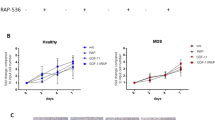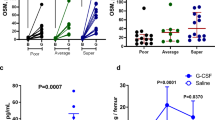Abstract
The balance between proangiogenic Angiopoietin-1 (Ang-1) and the antagonistic Ang-2 is important both for leukemogenesis and chemosensitivity in human acute myelogenous leukemia (AML). We examined the release of Ang-1 and Ang-2 by AML cells cultured alone and in cocultures with stromal cells. Detectable Ang-1 release from AML cells was observed for most patients (62/91), whereas Ang-2 release was detected only for a minority (23/91). Coculture of AML and stromal cells led to increased Ang-1 levels. Furthermore, the role of the angiopoietin system was investigated by characterizing whether the differences in angiopoietin expression in AML patients can be related to nucleophosmin (NPM1) mutations. We compared the gene expression profiles of AML cells derived from 19 patients with FLT3 mutations and normal cytogenetics with and without NPM1 mutations and observed increased expression of Ang-1 in patients with NPM1 mutations. Finally, we found significantly higher Ang-2 levels in serum of AML patients compared with healthy controls. Our results suggest that AML cells are a major source of Ang-1 in leukemic bone marrow, especially in patients with NPM1 mutations, but the local levels are also influenced by stromal cells. Local Ang-2 release from AML cells is less common, but high systemic levels of Ang-2 may affect bone marrow angioregulation.
This is a preview of subscription content, access via your institution
Access options
Subscribe to this journal
Receive 12 print issues and online access
$259.00 per year
only $21.58 per issue
Buy this article
- Purchase on Springer Link
- Instant access to full article PDF
Prices may be subject to local taxes which are calculated during checkout


Similar content being viewed by others
References
Falini B, Mecucci C, Tiacci E, Alcalay M, Rosati R, Pasqualucci L et al. Cytoplasmic nucleophosmin in acute myelogenous leukemia with a normal karyotype. N Engl J Med 2005; 352: 254–266.
Dohner K, Schlenk RF, Habdank M, Scholl C, Rucker FG, Corbacioglu A et al. Mutant nucleophosmin (NPM1) predicts favorable prognosis in younger adults with acute myeloid leukemia and normal cytogenetics: interaction with other gene mutations. Blood 2005; 106: 3740–3746.
Schnittger S, Schoch C, Kern W, Mecucci C, Tschulik C, Martelli MF et al. Nucleophosmin gene mutations are predictors of favorable prognosis in acute myelogenous leukemia with a normal karyotype. Blood 2005; 106: 3733–3739.
Suzuki T, Kiyoi H, Ozeki K, Tomita A, Yamaji S, Suzuki R et al. Clinical characteristics and prognostic implications of NPM1 mutations in acute myeloid leukemia. Blood 2005; 106: 2854–2861.
Thiede C, Koch S, Creutzig E, Steudel C, Illmer T, Schaich M et al. Prevalence and prognostic impact of NPM1 mutations in 1485 adult patients with acute myeloid leukemia (AML). Blood 2006; 107: 4011–4020.
Verhaak RG, Goudswaard CS, van Putten W, Bijl MA, Sanders MA, Hugens W et al. Mutations in nucleophosmin (NPM1) in acute myeloid leukemia (AML): association with other gene abnormalities and previously established gene expression signatures and their favorable prognostic significance. Blood 2005; 106: 3747–3754.
Zhang Y, Zhang M, Yang L, Xiao Z . NPM1 mutations in myelodysplastic syndromes and acute myeloid leukemia with normal karyotype. Leuk Res 2007; 31: 109–111.
Alcalay M, Tiacci E, Bergomas R, Bigerna B, Venturini E, Minardi SP et al. Acute myeloid leukemia bearing cytoplasmic nucleophosmin (NPMc+ AML) shows a distinct gene expression profile characterized by up-regulation of genes involved in stem-cell maintenance. Blood 2005; 106: 899–902.
Falini B, Nicoletti I, Martelli MF, Mecucci C . Acute myeloid leukemia carrying cytoplasmic/mutated nucleophosmin (NPMc+ AML): biologic and clinical features. Blood 2007; 109: 874–885.
Hatfield KJ, Olsnes AM, Gjertsen BT, Bruserud O . Antiangiogenic therapy in acute myelogenous leukemia: targeting of vascular endothelial growth factor and interleukin 8 as possible antileukemic strategies. Curr Cancer Drug Targets 2005; 5: 229–248.
Davis S, Aldrich TH, Jones PF, Acheson A, Compton DL, Jain V et al. Isolation of angiopoietin-1, a ligand for the TIE2 receptor, by secretion-trap expression cloning. Cell 1996; 87: 1161–1169.
Maisonpierre PC, Suri C, Jones PF, Bartunkova S, Wiegand SJ, Radziejewski C et al. Angiopoietin-2, a natural antagonist for Tie2 that disrupts in vivo angiogenesis. Science 1997; 277: 55–60.
Bruserud O, Hovland R, Wergeland L, Huang TS, Gjertsen BT . Flt3-mediated signaling in human acute myelogenous leukemia (AML) blasts: a functional characterization of Flt3-ligand effects in AML cell populations with and without genetic Flt3 abnormalities. Haematologica 2003; 88: 416–428.
Bruserud O, Ryningen A, Wergeland L, Glenjen NI, Gjertsen BT . Osteoblasts increase proliferation and release of pro-angiogenic interleukin 8 by native human acute myelogenous leukemia blasts. Haematologica 2004; 89: 391–402.
Anensen N, Oyan AM, Bourdon JC, Kalland KH, Bruserud O, Gjertsen BT . A distinct p53 protein isoform signature reflects the onset of induction chemotherapy for acute myeloid leukemia. Clin Cancer Res 2006; 12: 3985–3992.
Glenjen N, Ersvaer E, Ryningen A, Bruserud O . In vitro effects of native human acute myelogenous leukemia blasts on fibroblasts and osteoblasts. Int J Cancer 2004; 111: 858–867.
Hatfield K, Ryningen A, Corbascio M, Bruserud O . Microvascular endothelial cells increase proliferation and inhibit apoptosis of native human acute myelogenous leukemia blasts. Int J Cancer 2006; 119: 2313–2321.
Ryningen A, Wergeland L, Glenjen N, Gjertsen BT, Bruserud O . In vitro crosstalk between fibroblasts and native human acute myelogenous leukemia (AML) blasts via local cytokine networks results in increased proliferation and decreased apoptosis of AML cells as well as increased levels of proangiogenic Interleukin 8. Leuk Res 2005; 29: 185–196.
de Bont ES, Rosati S, Jacobs S, Kamps WA, Vellenga E . Increased bone marrow vascularization in patients with acute myeloid leukaemia: a possible role for vascular endothelial growth factor. Br J Haematol 2001; 113: 296–304.
Aguayo A, Estey E, Kantarjian H, Mansouri T, Gidel C, Keating M et al. Cellular vascular endothelial growth factor is a predictor of outcome in patients with acute myeloid leukemia. Blood 1999; 94: 3717–3721.
Gwang Kim J, Kyun Sohn S, Hwan Kim D, Ho Baek J, Young Lee N, Soo Suh J et al. Clinical implications of angiogenic factors in patients with acute or chronic leukemia: hepatocyte growth factor levels have prognostic impact, especially in patients with acute myeloid leukemia. Leuk Lymphoma 2005; 46: 885–891.
Loges S, Heil G, Bruweleit M, Schoder V, Butzal M, Fischer U et al. Analysis of concerted expression of angiogenic growth factors in acute myeloid leukemia: expression of angiopoietin-2 represents an independent prognostic factor for overall survival. J Clin Oncol 2005; 23: 1109–1117.
Schliemann C, Bieker R, Padro T, Kessler T, Hintelmann H, Buchner T et al. Expression of angiopoietins and their receptor Tie2 in the bone marrow of patients with acute myeloid leukemia. Haematologica 2006; 91: 1203–1211.
Schliemann C, Bieker R, Thoennissen N, Gerss J, Liersch R, Kessler T et al. Circulating angiopoietin-2 is a strong prognostic factor in acute myeloid leukemia. Leukemia 2007; 21: 1901–1906.
Bruserud O, Ryningen A, Olsnes AM, Stordrange L, Oyan AM, Kalland KH et al. Subclassification of patients with acute myelogenous leukemia based on chemokine responsiveness and constitutive chemokine release by their leukemic cells. Haematologica 2007; 92: 332–341.
Yuan ZR, Kobayashi N, Kohsaka T . Human Jagged 1 mutants cause liver defect in Alagille syndrome by overexpression of hepatocyte growth factor. J Mol Biol 2006; 356: 559–568.
Wakabayashi M, Miwa H, Shikami M, Hiramatsu A, Ikai T, Tajima E et al. Autocrine pathway of angiopoietins-Tie2 system in AML cells: association with phosphatidyl-inositol 3 kinase. Hematol J 2004; 5: 353–360.
Witzenbichler B, Maisonpierre PC, Jones P, Yancopoulos GD, Isner JM . Chemotactic properties of angiopoietin-1 and -2, ligands for the endothelial-specific receptor tyrosine kinase Tie2. J Biol Chem 1998; 273: 18514–18521.
Keith T, Araki Y, Ohyagi M, Hasegawa M, Yamamoto K, Kurata M et al. Regulation of angiogenesis in the bone marrow of myelodysplastic syndromes transforming to overt leukaemia. Br J Haematol 2007; 137: 206–215.
Acknowledgements
This study received financial support from the Norwegian Cancer Society, Helse Vest Research Fund, The Research Council of Norway and The Grieg Foundation. We thank Atle Brendehaug, Hua My Hoang and Sue Olsen for technical assistance concerning work with mutation analysis, DNA microarrays and real-time quantitative PCR, respectively. We also thank Kristin Paulsen and Aina Kvinnsland for technical support.
Author information
Authors and Affiliations
Corresponding author
Rights and permissions
About this article
Cite this article
Hatfield, K., Hovland, R., Øyan, A. et al. Release of angiopoietin-1 by primary human acute myelogenous leukemia cells is associated with mutations of nucleophosmin, increased by bone marrow stromal cells and possibly antagonized by high systemic angiopoietin-2 levels. Leukemia 22, 287–293 (2008). https://doi.org/10.1038/sj.leu.2404985
Received:
Revised:
Accepted:
Published:
Issue Date:
DOI: https://doi.org/10.1038/sj.leu.2404985
Keywords
This article is cited by
-
Reliable FASP-based procedures for optimal quantitative proteomic and phosphoproteomic analysis on samples from acute myeloid leukemia patients
Biological Procedures Online (2016)
-
Molecular profiling of blastic plasmacytoid dendritic cell neoplasm reveals a unique pattern and suggests selective sensitivity to NF-kB pathway inhibition
Leukemia (2014)
-
The surface molecule signature of primary human acute myeloid leukemia (AML) cells is highly associated with NPM1 mutation status
Leukemia (2012)
-
Clinical relevance of angiopoietin-1, angiopoietin-2, and their receptor Tie-2 expression in acute myeloid leukemia
Comparative Clinical Pathology (2012)
-
Clinical relevance of angiopoietin-1, angiopoietin-2, and their receptor Tie-2 expression in acute myeloid leukemia
Comparative Clinical Pathology (2011)



